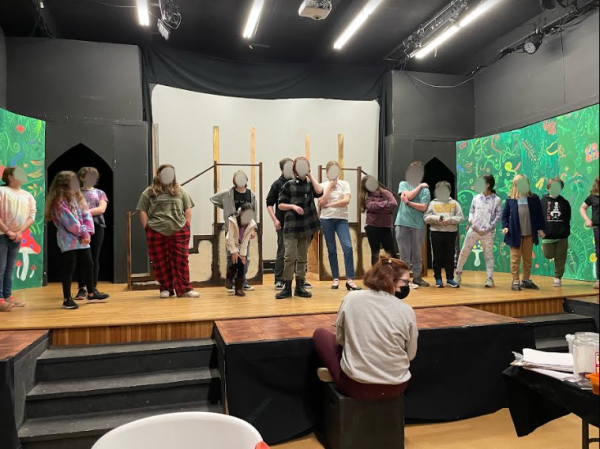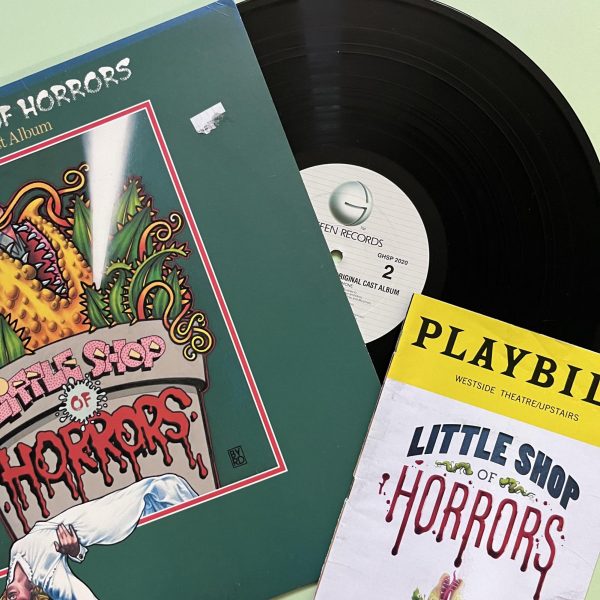
Typecasting is a major issue in the theater community. Typecasting is when an actor or actress is repetitively cast in the same type of role, based on their personality, body type, race, or physical appearance. They also can be cast in the same type of role based on their previous experiences and what they are known to do well. I have been subjected to typecasting. I have only ever been cast as tenor males or, to simply put it, I play guys with character voices. I have played a range of characters from Pinocchio with a high-pitched voice, to Gomez with a deeper Latino accent, to SpongeBob who has a very specific character voice. While I was not typecast via my body, I have only been cast through one type of character. Typecasting, however, can have a severely negative impact on the theater community. It needs to be stopped. Casting directors must look at the entirety of an actor who comes in auditioning for a role, instead of just specific parts and typecast them.
Typecasting stifles actors’ creativity and opportunities by only allowing them to portray certain roles and allowing them to expand their capabilities. When this occurs, there are many “types of characters” that actors can be cast as. Generally, they will be cast in the same types of roles every time. They can be anything from funny side characters, to somber old men. For example, there is the “Juvenile” who is usually a twenty to thirty-year-old man who is the lead guy. He has a specific personality of being child-like and looks more on the handsome side. There is the “Low Comedian” who often is good at comedy and takes after Robin Williams (Moston). Regardless of which character we are talking about, they all have meet the criteria of typecasting. Other types of characters may fall under physical mannerisms or an ethnicity. For example, an actor who uses bigger gestures when talking may be cast as a sales person. If actors are of a certain ethnicity, they may be looked at stereotypically. Even simply gender: women are typically play nurses or babysitters (Bensten). This does not allow actors to expand their creativity and abilities.
As I see it, they get put into a box which is difficult to escape. As much as they may push and try, they cannot unpack themselves. They are only seen as this one specific type of role; they then get stifled and creatively burnt out. They can lose their opportunities because they cannot step out of their box. Not only that, but they may want to be able to show their abilities in different roles or emotions or different activities within their capabilities, but they are always stuck in the same types of roles. Alongside this, actors may not be able to book other shows because they never have an opportunity to demonstrate their capabilities. This negatively impacts the actors and actresses, preventing them from expanding their careers. Cuauhtli Jiménez shares his experience as an actor being typecast. As a Mexican actor, he would always be type cast by his looks and would be put into characters that were criminals or traffickers. He wishes he could expand the roles that he plays, rather than being stuck in the same types of characters. (Cuauhtli).
Casting directors need to make casting decisions by looking at the entirety of a performer. They need to be able to make sure that the actors can play the part vocally, they have the physical capabilities of the role, and that they take into account everything of this actor, not relying on first impressions. They need to use auditions, and they should look at initial impressions, how people present themselves, and what people bring into auditions. They should be sure to listen to their voices and to explore their ranges. Furthermore, they must ask them about their experience, watch how quickly they can pick up choreography, how they present themselves on stage, as well as how they preform dry readings for certain characters. Likewise, they should give actors some leeway to try out new types of characters and make them their own.

As actors begin to play the same roles over and over again, they “begin to see it as a job” (Glaser). People’s passions and true capabilities can be hidden. Only a director who truly looks at each actor to see what they can do will discover the range of talent in an actor. In many directors’ cases, they do look at many criteria. Cristal Philbrick, a youth theater director, (seen to the right directing kids) makes sure she takes into account all of her kids’ capabilities when she casts: “I make sure to understand a person’s full range of abilities as an actor, not just what they look like. I ask the kids what they want as a character, and put that in my head, but that only really works for youth casting.” She details her casting process and her views on typecasting “Type casting is wrong, and it limits people’s abilities. There’s no appreciation of the whole person, only limited to what you can see. We should absolutely get rid of typecasting” (Philbrick). As a director, she makes sure to reinforce the idea of looking at the entirety of an actor and take their full talent into consideration.
Jules Vasas, a 16-year-old actor, who uses they/them pronouns, agrees with this. Typecasting can differ in perspective. Many professionals in the field see typecasting as different ideas. Some see it as something that just has to do with race, while others see it as a personality casting choice, and others will see it as a combined issue. They, Jules, experienced being typecast as a positive and “bubbly individual”. Vasas is put into the “comedic side character” role. They pointed out how typecasting should be abolished because of the negative impacts it can create. Vasas said, “Directors should take into deep consideration all of an individual’s strengths and weaknesses when casting a show.” Additionally, Vasas goes to ECA for this school’s theater program, and they see a ton of typecasting happening even within this community. They have witnessed how teachers and directors, who work at ECA, seem to put the kids in the same type of roles repetitively, which results in not letting them expand what they can achieve. Vasas reiterates that typecasting is a hard to avoid issue in the theater community, but there are ways around it (Vasas).

Can typecasting be broken? The simple answer is yes and no. It is very difficult for one to break out of their typecast. Actors need to make sure they are able to bring their A-game to auditions, and it also helps when they have a director who is open to new ideas. Typecasting is a super subjective term to people, and it can be argued how “certain characters need to be typecast.” Take Regina George from Mean Girls the Musical (right) as an example. Usually she is a white “skinny” female, as her character is prized on her body and being an attractive woman. In the song Meet the Plastics, Regina George has a lyric that says, “I’m the prettiest girl that you’ve ever seen. I never weigh more than 115” (Mean Girls). Directors typically cast her as a skinny female. However, does she need to be? Not really. Regina George is a character, so if she believes she embodies that spirit, regardless of what her body looks like, that is confidence that the part needs. The idea of needing to be a certain physical size to articulate the “spirit” of this character is unrealistic in our evolving society. This idea of typecasting doesn’t have to happen. Casting can be up for interpretation.

There are actresses who were able to break the usual stereotypes. Casting Directors of Little Shop of Horrors, an off-Broadway run, branched off from the usual skinny Caucasian female, and their races have been ranged from the usual Caucasian female to other races and ethnicities. They have cast Joy Woods, a Black actress, as Audrey. She originated the role of one of the Urchins when they first re-opened. She created a new meaning to the role of Audrey with show stopping numbers, showing phenomenal vocals, and excellent character choices. The most recent actress playing Audrey is Constance Wu. She is a Taiwanese actress who made her off-Broadway debut with this role. Her director took a chance and allowed her to try new roles. Finally, in the show Legally Blonde, the leading female named Elle Woods, is typically a Caucasian, skinny female. In the 2021 West End production of Legally Blonde, an actress named Courtney Bowman, an Afro-European, portrayed the role of Elle Woods. She was a phenomenal actress and this role was perfect for her. All of these are examples of directors an actor’s full capabilities to try to break that typecasting barrier.
However, there are some roles that do require forms of typecasting so it correctly represents certain groups. An example of this is the musical Hairspray. In this musical, it addresses the topic of racism to people of color. These characters need to be Black people for the story to make sense. But this is a necessity for the story and issues being discussed. Another example of a “necessary” type casting is in Heathers the Musical. This show features a supporting role named Martha Dunsstock. Usually, this character is a plus-sized female. Her weight is referenced many times in the musical, with lines like “Martha Dumptruck” or comparing her to a pig piñata who has a resemblance to her. Both of the reasons show how representation in these issues is important not only to audience but also to storyline reasons. Without these plot points being portrayed by the correct people and showing capabilities of people who fit the role, the musical would become thrown off and not make sense. Sometimes characters are typecasting purely for aesthetic reasons. Casting directors will cast actors and actresses in roles, so the audience will be pleased, as there has been public “outburst” about certain characters being changed or not looking like what the audience thinks they should look like.
Typecasting can impact actors and actresses everywhere, stifling their creativity and opportunities. To prevent this ongoing issue, casting directors need to make sure they cast actors in roles that suit their talents. Typecasting can be broken, and the theater community is taking steps to eliminate this issue. As an actor, it can be difficult to see a robust acting future when the idea of typecasting is still so prevalent in today’s theater world.
Works Cited
Bentsen, Martin. “Type Casting in Acting 2023, All You Need to Know.” Martin Bentsen Actor Marketing Consultant, Martin Bentsen, 1 Jan. 2023, www.cityheadshots.com/blog/type-casting-acting#:~:text=When%20actors%20are%20%22typecast%2C%22,playing%20those%20kinds%20of%20characters. Accessed 5 Dec. 2023.
“Constance Wu: Somewhere That’s Green | #LittleShopNYC.” Youtube, 6 Dec. 2023, www.youtube.com/watch?v=bArg11grcF0. Accessed 12 Mar. 2024.
“Ethan Slater Sings ‘Best Day Ever’ from The SpongeBob Musical: Live on Stage! | SpongeBob.” Youtube, 5 Dec. 2019, www.youtube.com/watch?v=0dtbQBJdoWk. Accessed 12 Mar. 2024.
Glaser, Blair. “Typecasting, Women & Weight.” Playbill, 17 Apr. 1997, playbill.com/article/typecasting-women-weight-com-101717. Accessed 14 Dec. 2023.
“Joy Woods is Audrey – SUDDENLY, SEYMOUR with Matt Doyle | Little Shop of Horrors.” Youtube, 4 Apr. 2023, www.youtube.com/watch?v=5dixrnDm9zw. Accessed 12 Mar. 2024.
“Legally Blonde | West End LIVE 2022.” Youtube, 25 June 2022, www.youtube.com/watch?v=IZs40JGVX-E. Accessed 13 Mar. 2024.
Mean Girls the Musical, Meet the plastics. Performance by Taylor Louderman, Lorne Michaels and Stuart Thompson, 2017.
Moston, Doug. “Type Casting.” Backstage, Mar. 2013, www.backstage.com/magazine/article/type-casting-16507/. Accessed 5 Dec. 2023.
Philbrick, Cristal Ann. Personal interview with the author. 5 Dec. 2023.
Translated by Content Engine LLC. (2022). Cuauhtli Jiménez, against typecasting. In CE Noticias Financieras (English ed.). ContentEngine LLC, a Florida limited liability company.
Vasas, Jules. Personal interview with the author. 5 Dec. 2023.
Wolfe, Aslin. Cristal Philbrick Directing Addams Family Actors. Photos App.
—. Little Shop of Horrors Vinyl Collage. 2024, Private Collection. Photogragh.
—. Mean girls Vinyl Collage. 2024, Private Collection. Photogragh.
—. Spongebob the musical Vinyl Collage. 2024, Private Collection. Photograph.

